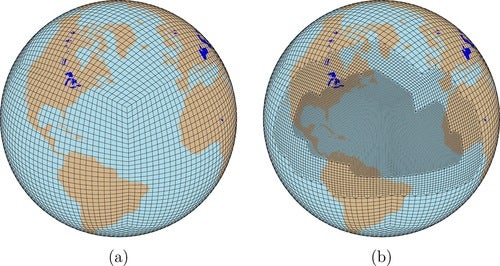3A. MUlti-Scale Infrastructure for Chemistry and Aerosols (MUSICA)
ACOM has begun the planning process to develop a computationally feasible global modeling infrastructure that allows for simulation of large-scale atmospheric phenomena, while still resolving chemistry at emission and exposure relevant scales. Critical applications are (1) the representation of air quality in urban regions and (2) interactions between atmospheric chemistry, and weather and climate. These applications will require comprehensive chemical modeling at fine horizontal (down to ~4 km, obtained through regional refinement) and vertical (multiple layers in the urban canopy) resolution within a global modeling system. This will allow the two-way coupling between phenomena that occur on the urban, regional and global scales. For example, it will allow examination of the effects of wildfires in remote regions on urban air-quality, or improvements in S2S AQ prediction from better representation of the teleconnections in global-scale phenomena such as ENSO, QBO, and MJO, all within a single modeling framework.
The first step of this project is to implement gas phase and heterogeneous chemistry (i.e., aerosol and cloud chemistry) in a Model Independent Chemistry Module (MICM, Section 3H) that satisfies the requirements of a Common Physics Framework (CPF). MUSICA will have a flexible design to handle a variety of gas phase and aerosol schemes under the CPF. MCIM defines the infrastructure required to specify chemical reactions and photolysis, and solve the associated differential equations. It enables community users to implement their own system of chemical reactions (via the Chemistry Cafe) and other input parameters, including surface emission and deposition rates.
In a second step MICM will be integrated within a host global model, i.e., the unified atmosphere model being defined under the NCAR Singletrack project. Versions of this unified system will be adapted for specific scientific or operational purposes including short-term chemical weather predictions (including downscaling for regional air quality predictions) or longer-term chemical climate projections (including a detailed representation of middle and upper atmosphere processes). When completed, the system is expected to become a central tool for operational global to regional air quality predictions.
In parallel to these efforts, ACOM scientists are utilizing new capabilities in CESM to assess conduct global chemistry simulations using CAM-CHEM in on a model grid with regional refinement. Below is an example of such a grid (Zarzycki et al., 2015), where a high resolution domain is embedded in a 1˚ uniform mesh. Such models will allow improved air quality forecasts over urban areas, where emission sources are far more localized.
The MUlti-Scale Infrastructure for Chemistry and Aerosols (MUSICA) and its components will be open source and flexible in order to facilitate community co-development and use for scientific and operational purposes. Its development will involve new strategic partnerships with universities and other interested research centers. The development of MUSICA will be guided by an advisory panel and will be directed by a steering committee that includes committed representatives of the broad research community.
References:
Zarzycki, C.M., C. Jablonowski, D.R. Thatcher, and M.A. Taylor, 2015: Effects of Localized Grid Refinement on the General Circulation and Climatology in the Community Atmosphere Model. J. Climate, 28, 2777–2803, https://doi.org/10.1175/JCLI-D-14-00599.1
Contact
Please direct questions/comments about this page to:
Carl Drews
NSF NCAR | Research IT | ACOM
